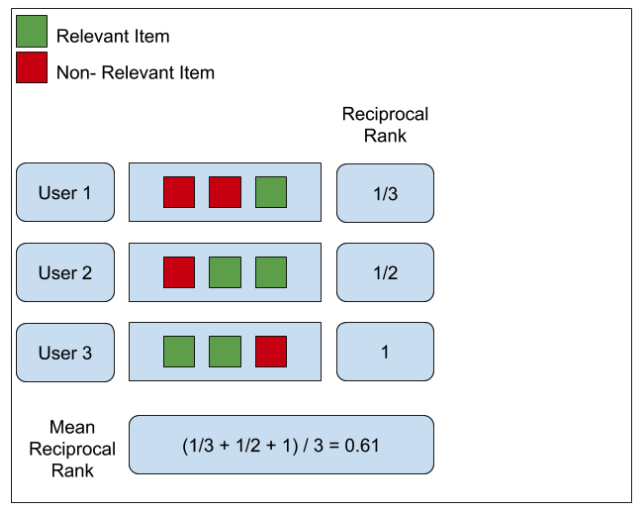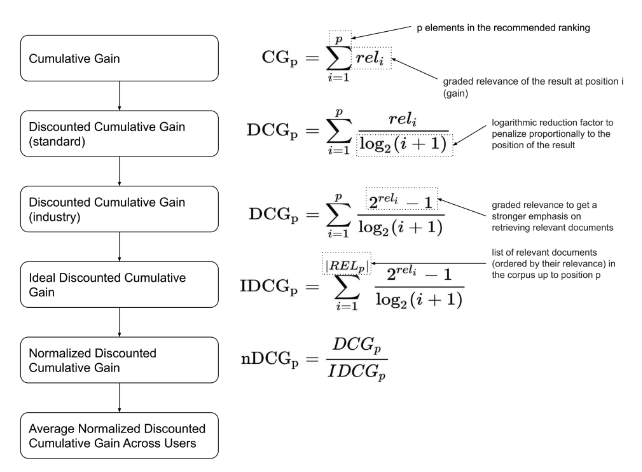Retrieval Metrics¶
0. Understanding AutoRAG’s retrieval_gt¶
✅Basic Example¶
(sample) retrieval gt = [['test-1', 'test-2'], ['test-3']]
(sample) retrieval result = ['test-1', 'pred-1', 'test-2', 'pred-3']
As you can see from the gt, retrieval_result must contain either ‘test-1 or test-2’ and test-3 for all answers to be accepted as correct.
So, if we labeled the retrieval_result as ‘1’ for a correct answer and ‘0’ for an incorrect answer, it would
be [1, 0, 1, 0].
For more information, please refer to the following Dataset Format Docs.
In the Apply ‘✅Basic Examples’ below, we’ll use the following sample gt and result. Hopefully you remember them well.
Tip
Looking for retrieval metric that do not need any retrieval ground truth? We support Ragas context precision metric also.
1. Precision¶
📌Definition¶
Precision is the percentage of what the model classifies as true that is actually true.
Also known as PPV (Positive Predictive Value).
❗So in AutoRAG, Precision is (number of correct answers in a result) / (length of a result).
✅Apply Basic Example¶
Retrieval resulted in the correct answer [1, 0, 1, 0].
Precision = (number of correct answers in a result) / (length of a result).
So in this case, precision is 2/4 = 0.5.
⌛Summary
Precision = 2/4 = 0.5
2. Recall¶
📌Definition¶
Recall is the percentage of what the model predicts to be true out of what is actually true.
In statistics, it’s known as sensitivity, and in other fields, the term hit rate.
❗Thus, in AutoRAG, Recall is (number of correct answers in the list in gt) / (length of gt).
✅Apply Basic Example¶
Recall = (number of correct answers in the list in gt) / (length of gt). So in this case, We need to see how many of the two lists in gt contain the correct answer.
['test-1', 'test-2']The list is correct if at least one of the two correct answers in the list is included in the result. The result contains both
test-1andtest-2.Therefore, this list is correct.
['test-3']The result doesn’t include
test-3.Therefore, this list is incorrect.
The ‘number of lists containing the correct answer’ was 1, and the ‘length of gt’ is 2.
Therefore, Recall is 1/2 = 0.5.
⌛Summary
Recall = 1/2 = 0.5
3. F1 Score¶
📌Definition¶
F1 score is the harmonic mean of Precision and Recall.

✅Apply Basic Example¶
Consider the result values above.
Precision = 0.5 and Recall = 0.5.
Therefore, the F1 Score = 2*(0.5*0.5)/(0.5+0.5) = 0.5
⌛Summary
Recall = 1/2 = 0.5
4. MRR (Mean Reciprocal Rank)¶
📌Definition¶
MRR (Mean Reciprocal Rank) is the average of Reciprocal Rank of the most relevant passage.

✅Apply Basic Example¶
['test-1', 'test-2']Let’s find the position of
test-1andtest-2in the result, whichever comes first.Since test-1 is the first in result, the RR of this list is 1
['test-3']The result doesn’t include
test-3.Therefore, the RR of this list is 0.
Therefore, the MRR is (1 + 0) / 2 = 1/2.
⌛Summary
RR list = [ 1, 0 ]
MRR = 1/2
5. MAP (Mean Average Precision)¶
📌Definition¶
MAP(Mean Average Precision) is exactly what it sounds like: the average of Average Precision (AP), or the average of the averages.
Calculate in this order: Precision → Average Precision → Mean Average Precision

✅Apply Basic Example¶
['test-1', 'test-2']test-1is in the first part of result. Therefore, Precision = 1test-2is in the third of the result. Therefore, Precision = 2/3
⇒ AP (Average Precision) = (1 + 2/3) / 2 = 5/6
['test-3']test-3is not included in the result. Therefore, Precision = 0, AP = 0
⇒ So, MRR = (1 + 0) / 2 = 1/2
⌛Summary
Precision → Average Precision → Mean Average Precision
6. NDCG (Normalized Discounted Cumulative Gain)¶
📌Definition¶
Calculate in this order: CG → DCG → IDCG → NDCG

1️⃣CG (Cumulated Gain)
Cumulated Gain (CG) literally means the cumulative sum of relevance. However, in the case of CG, if the types of passages in TopN are the same, a model with more relevant passages ranked higher may perform equally well as a model with less relevant passages.
Therefore, we don’t use this value directly but use the DCG with a discount.
2️⃣DCG (Discounted Cumulated Gain)
Discounted Cumulated Gain (DCG) is the sum of the relevance divided by the logarithmic rank.
Logarithmicizing the ranking results in a modest increase in value, and dividing relevance by this value indicates that the impact of relevance is smaller the further down the ranking you go.
In DCG, discounted means to reduce the influence of these later rankings, so that the value of the DCG is more influenced by the relevance of higher-ranked items and less influenced by the relevance of lower-ranked items.

3️⃣IDCG (Ideal-Discounted Cumulated Gain)
The Ideal Discounted Cumulated Gain (IDCG) is the most ideal value of the DCG result. It is absolute and not directly related to the model.
4️⃣NDCG
The normalized Discounted Cumulated Gain (nDCG) refers to the normalized DCG, which means that the DCG for the model’s ranking is divided by the ideal DCG, or IDCG, to give a value between 0 and 1.

NDCG = DCG / IDCG
✅Apply Basic Example¶
If retrieval_result is labeled 1 for the correct answer and 0 for the incorrect answer,
then [1, 0, 1, 0].
DCG = 1 / log2(1+1) + 0 + 1 / log2(1+3) = 1.5.
For IDCG, it is ideal if the result contains all of the correct answers test-1, 2, and 3. So the ideal result is
[1, 1, 1, 0]. IDCG = 1/log2(1+1) + 1/log2(1+2) + 1 / log2(1+3).Therefore, NDCG = DCG / IDCG = 0.7039180890341347.